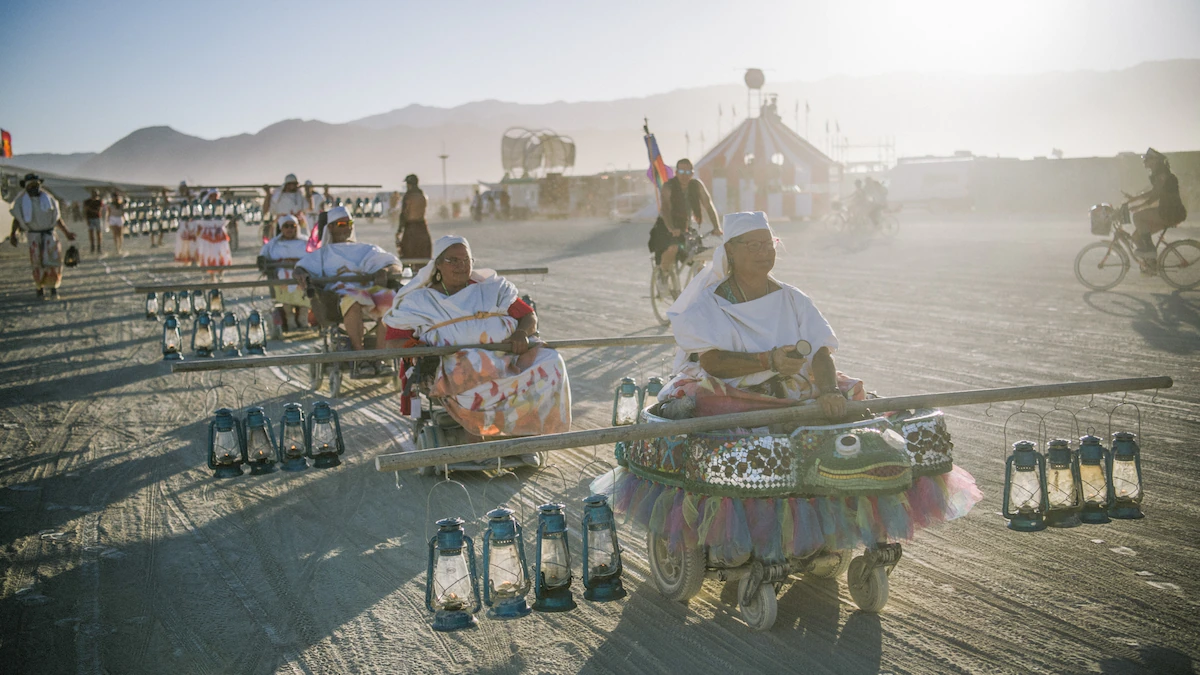Published August 31, 2022
14 min read
In a ceremony that has taken place every year since 1993, a procession of people called “Lamplighters” dressed in robes embellished with embroidered flames has led Burning Man revelers to the festival’s namesake art installation. As darkness settles across the northern Nevada desert, the colossal wood, burlap, and wax statue is set aflame, marking the penultimate night in a weeklong celebration that promotes “radical inclusion.”
That “all are welcome” ethos is a key principle of Burning Man, a desert spectacle where (almost) anything goes. Even so, Dani Moore—known as “Rat Lady” to fellow Burners—helped make history. Moore was one of the first Lamplighters to use a wheelchair, leaving her tracks alongside footprints in the dust. She’s among hundreds of people with physical limitations who participate in the famous festival through Mobility Camp.
Founded by Dale Huntsman as Hot Wheelz Camp sometime around 2000, Mobility Camp is a volunteer-led group within Burning Man that makes camping, an essential part of the experience, more accessible. The group provides charging stations for medical equipment and one of the few accessible transport vehicles—a 1940s Gibson tractor and trailer decorated to match that year’s creative theme—to the art installations scattered across the desert.
Mobility Camp is one of many affinity groups within Burning Man that help foster a sense of community in the desert, but it’s not the only one. Festivals over the years have included Da Dirty Hands, a community for Deaf festivalgoers, Blind Burners, a community of blind, partially sighted and sighted artists and volunteers making Burning Man more accessible for blind people, and camps like Uni-Corny, which caters to people who have food allergies.
One of the oldest operating accessible groups, Mobility Camp shows how festivals can be more inclusive by providing wheelchair-friendly transportation and support services, with differently abled leaders who can ensure a truly accessible community event.
Equity in the desert
The festival’s guiding principles state that “anyone may be a part of Burning Man,” but its harsh desert environment can be particularly punishing for people with disabilities. Although Burning Man began in San Francisco in 1986, in 1991 it moved to Black Rock, an arid region of rugged canyons and dry lake beds more than 100 miles north of Reno, Nevada.
Before the pandemic, some 70,000 to 80,000 participants made the annual trek out to Black Rock, building a makeshift, crescent-shaped metropolis across seven square miles of terrain known as the playa (the Spanish word for beach). Using materials they pack in, Burners construct camps, communal buildings, and the outsized art pieces that make the festival so distinctive. At festival’s end, they tear everything down and haul out every last bit. All this happens amid temperatures north of 100 degrees Fahrenheit, peppered by unpredictable sandstorms.
“The dust storms are bad—the dust and sand are corrosive to wheelchairs. And Burning Man is so huge that you can get stranded. Most wheelchairs just don’t have the battery range to travel all the way from the campsites out to the playa, where the art is,” says Moore, the leader of Mobility Camp. “I knew people who had great stories from attending Burning Man, but they told me that there’s no way I could do that in a wheelchair.”
(For travelers with disabilities, video games are windows to the world.)
But all that is changing. Moore says that in 2019, 85 percent of people—from children to the elderly—who signed up to stay with Mobility Camp reported having a disability. (The camp is also open to people who do not have disabilities and are looking for quieter, substance-free accommodations.) When photographer Morgan Lieberman visited that year, she met people who weren’t just surviving but were thriving.
Her photographs reveal a community where members help and support each other, whether that means applying temporary tattoos, commuting to the playa, or bedazzling wheelchairs and crutches.
“Burning Man is a very visual community, so there are lots of pictures online where it seems like everyone is on a bike. You think, ‘Oh, this is a place for able-bodied people,’ but it’s not,” says Lieberman. “My goal was to go there and document real moments of joy and intimacy that people of all abilities feel in this space.”
For Emily Jacobs, Burning Man had a profound impact on her well-being. After a 2010 car accident resulted in her losing her leg, she struggled to adapt to her new normal. Six years and 37 surgeries later, she was lonely, something many people who identify as differently abled experience because they are often isolated from their peers or not accommodated.
Jacobs received a ticket to the festival as a gift from the man who lost control of his car and caused the crash that took her leg. “We had become friends, and he thought Burning Man might be a beneficial place for me,” she says.
“The first hour of my first year there I was terrified. [I was] by myself, in pain, setting up camp amongst strangers,” Jacobs remembers. “I hadn’t even ridden a bike since before my accident, so I didn’t know what would happen.” At the time, Jacobs’ doctors had only recently cleared her to do weig

